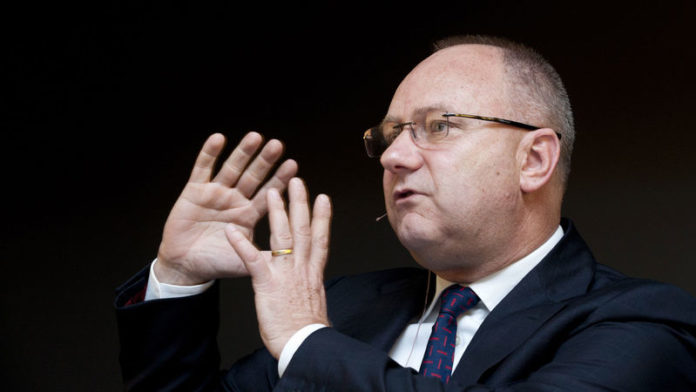
ANGLO American’s remarkable turnaround under CEO, Mark Cutifani, has been rightly applauded. Now, however, there are the inevitable questions as to whether the $800m interim dividend payment announced earlier this month, supplemented by a surprise $1bn share buy-back programme, represents apogee for the firm. As asked by analysts: is this is “as good as it gets” for Anglo?.
Apparently not.
Investment banks, including JP Morgan Cazenove, HSBC, RBC Capital Markets, Morgan Stanley, and Goldman Sachns think Anglo American has more in the tank, although it does depend on the usual imponderables such as the strength of the iron ore market, and whether Anglo can tackle the 3% overall shortfall in first half production.
There are also questions regarding how long it can take advantage of technical advances born of Cutifani’s strategy to rebuild the group’s ability to mine efficiently, said to have been lost under predecessor, Cynthia Carroll. This risk is ultimately, the question of how long Anglo’s efficiency and cost gains can remain ‘locked in’ before competitors catch up.
First, though, the payout.
Asked whether the buy-back could become a regular occurrence in Anglo’s capital allocation framework, Stephen Pearce, the group’s CFO, said it would a “one-off”. Given that elevated iron ore prices played an important part in Anglo’s interim earnings, a connection is being made between Anglo’s performance and the sustainability of the R9.9bn dividend paid by its 70%-owned Kumba Iron Ore subsidiary, listed on the JSE.
The Brumadinho tragedy at the beginning of this year in which a tailings dam burst at the Brazilian facilities of that country’s state-owned mining company, Vale, resulted in it producing only 320 million tons (Mt) of the 380Mt in iron ore it would normally sell. Whilst 15Mt to 20Mt of opportunistic production has entered the market from other sources, the deficit in iron ore production seems here to stay, at least for the remainder of the financial year, said Timo Smit, Kumba’s marketing director.
Analysts agree: “Although we expect iron ore prices to ease lower from current levels, we are above consensus, and in the environment of robust pricing, we see Kumba continuing to pay a healthy dividend currently yielding an average of about 10% over the next two years,” said Grant Sporre, an anaylst for Macquarie.
In any event, a weakening in the iron ore price will be offset by the share buy-back which provides a defensive underpin to the earnings outlook.
And it’s not just iron ore adding strength to Anglo’s arm: the presence of platinum group metals (PGMs) in the Anglo portfolio via its 80% stake in Anglo American Platinum (Amplats) as well as De Beers, offers balance in commodity exposure and “… a differentiated investment case [that] will likely remain the distinguishing factor within the metals and mining space,” said an analyst that is not permitted to be quoted by media.
As for the slight under-performance on production in the first half, Anglo reckons the unplanned plant maintenance problems that hindered Kumba are unlikely to be repeated. It is similarly positive about its ability to make ups shortfalls in first half production from its metallurgical coal and platinum production.
The possibility there may be delays in the renewal of an iron ore tailings licence at Anglo’s Minas Rio facilities in Brazil given the high sensitivity the government has towards safety in waste storage has also been played down by Anglo. At any rate, Anglo has until the second quarter of 2020 to secure the renewal.
One of the larger issues for Anglo, however, is its ability to keep innovating in terms an efficiency drive that has been underway for most of the six years Cutifani has been in the driving seat at the group.
Citing a roundtable meeting with Anglo management following the numbers, Bank of America Merrill Lynch (BoAML) said Anglo had approached improvements to its cost base from a bottom up approach rather than the normal top down of its peer group.
If a company pushes a 10% cost cut down on to operating assets, there is a very high risk that operators will cut sustaining and development capital expenditure to boost near-term cash flows, the bank said. This merely defers the spend and causes bigger problems “down the road … Anglo thinks it did it the right way and that other companies may have done it the wrong way,” said BoAML.
Anglo thinks it as a three to five year head start on its peers and estimates it can drive a $2bn to $3bn in costs and volume improvements by the close of its 2022 financial year. “But it’s all about execution,” said Tony O’Neill, Anglo American’s technical director.
So much depends on the strength of the markets to which Anglo is exposed. According to Dominic O’Kane, an analyst for JP Morgan Cazenove, Anglo’s 5% payout of market capitalisation at the interim stage could be extended to 35% of market cap by Anglo’s 2020 financial year. “This clearly shows the returns potential and capital flexibility for Anglo,” said O’Kane, adding however that this was “… a consistent theme” across all the diversified mining firms with iron ore production.











